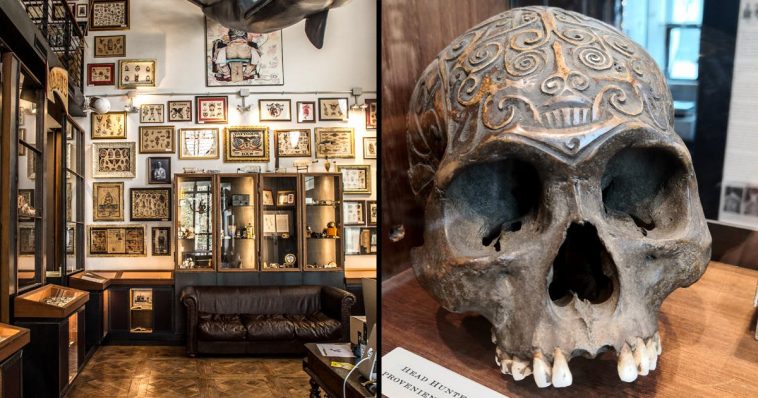Roma Tattoo Museum is a celebration, an act of love and respect towards tattoo history and everything it represents. It shows in every corner, in every frame hung on the high walls kissed by sunlight entering through the huge glass windows; it shows in every relic and memorabilia with a story to tell, patiently collected over the years just for the sake of it, before the Museum was even an idea or a possibility; the dedication behind this extensive collection is undeniable and very clear.
“Raccoglievo perché amavo”, the owner, Kubo, told me over the phone a few days ago when I asked how, and why, he started collecting all these objects: “I collected because I loved." He really does.
Roma Tattoo Museum is a hidden gem in a city, Rome, full of very well known gems. The Museum is part of a building from the 1800s located in the Parioli district, specifically in the area of Acqua Acetosa. A historically important structure, it is protected by the Cultural Heritage Management.
The property was taken over by an important contemporary master, the painter Bruno Bruni (Bruno D’Acervia). From its high windows, one can catch sight of the Acqua Acetosa fountain, attributed to Gian Lorenzo Bernini, only a few meters away. The roofs and ceilings, with their original wooden beams, frame the prestigious collection, and the space has been deliberately left as antique as possible, to harmonize with the historical artifacts and ancient equipment.
Today the building hosts the collection of the museum - a permanent, yet always evolving private collection, with free entry at all times - and a fully functional tattoo studio, where resident artists and valuable guests from all over the world express their art, surrounded by magic inspiration and breathing tattoo history. A great place to inspire and get inspired.
We don’t use the word “history” by chance here. Roma Tattoo Museum hosted for two months a few years back the late and beloved Lyle Tuttle, while today is home to one of the greatest tattoo masters of Italian history, Gippi Rondinella. The essence of tattooing, especially in the old days, has always been about traveling, getting to know other artists, sharing knowledge, techniques and experiences, and this is the spirit behind the idea of the Museum today. The space is always open to exhibitions, seminars and other related events. Anything worth sharing.
The collection of tattoo equipment, tattoo flash, illustrations and artifacts is amazing. Just walking through the different areas one travels from south east Asia to Japan, from the East to the West Coast in America, and all over Europe through the last centuries. It is the result of more than thirty years of relations and exchanges with other major collectors around the world, as well as other tattoo museums.
The Equipment display includes tattoo machines owned by artists such as Mike Malone, Cindy Ray, Owen Jensen, Charlie Wagner, Bob Wood, Percy Waters, Doc Forest, Lyle Tuttle of course, Tattoo Peter (the only machines with a wooden grip), an original tattoo machine owned by Amund Dietzel (1890-1973) - which stands out among the others for the very long tip, the man had huge hands - as well as original acetates and a tattoo machine owned by Sailor Jerry himself.
A few interesting elements on display all lead to the commercial genius of Milton Zeis (1901-1972). He was a man of many talents: businessman, commercial artist, performer, author, publisher, tattoo supplier and tattooist. His fascination with tattooing came at an early age, and for nearly 20 years he owned a shop that was a tattoo studio on one side and a tattoo supply business on the other. He sold flash, pigments, machines, and other supplies. The Zeis School of Tattooing and its related course were a natural extension of the studio and the supply business. First published in 1951, the Zeis course included 20 lessons and sold for $125.00. The Museum displays a complete Zeis tattoo kit that used to be for sale and the Zeis School of Tattooing lessons.
The collection of tattoo flash on display is extensive and varied: original art from Red Gibbons, Owen Jensen, Percy Waters, Danny Denzl, Bert Grimm, original Indian flash from Gippi Rondinella’s personal collection.
One of the most valuable pieces is definitely an original George Burchett drawing. Known as the “King of Tattooists,” George Burchett was arguably the most famous tattoo artist of his time. Tattooing in London throughout the first part of the 20th century, he catered to both the social elite and the working class, as well as members of the Royal family.
A collection of tattoo-related oddities on display includes the purchase order for the service and pictures of Al Orsini tattooing a fresh cadaver, rate: 25$ per tattoo; a carved human skull from Borneo, Japanese Hakata dolls with a twist, doorbell tattoo machines, some rudimentary jail tattoo equipment and much more.
A small part of the collection is dedicated to equipment and artifacts from Thailand, original antique Sak Yant tattooing needles and flash, Borneo, human skulls and needles made from wild boar teeth, a couple of precious elements from Japan.
Talking about South East Asia, the Museum hosts a rare gem: almost half the material that once belonged to Swallow Tattoo from Hong Kong. The tattoo scene in Hong Kong spans over four decades and it’s closely linked to the wars that were fought in the area. The first tattoo parlor was Rose Tattoo Studio, opened in 1946. The owner, James Ho, later took on four apprentices at the studio: Ricky, Benny Tsoi, Pinky Yun, and a young teenager, named Lai Shue Keung, who later became known as Swallow. Thanks to the huge demand, only a few years later both Ricky and Swallow opened their own tattoo shop just a few blocks away from Rose Tattoo Studio.
Hong Kong 's importance as a strategic port meant that there would never be a shortage of fighting men arriving here for brief periods of rest and recreation before going back, in many cases, to meet their death. Wanchai became an international playground for the thousands of newly arrived troops, full of massage parlors, street girls, and speakeasy bars which stayed open after the official bars had closed. And with tattooing as popular as ever among American, British and Australian servicemen, the district's tattoo parlors did a roaring trade.
Eventually all the wars ended, foreign troops left the area and the following decades were not as lucky as the early years. The Chinese population in Hong Kong was quite conservative and mostly adhered to Confucian teachings, including the one stating that the human body was sacred and not to be tampered with.
Moreover, most tattooists couldn’t draw or tattoo without a stencil, and all they had on their walls were military icons and drawings or patriotic emblems, nothing really appealing for a new public. So from the late 1970s until the early 1990s, tattooing stagnated and was hidden from public sight; when Swallow realized that the tattooing days were over, he retired to spiritual life. After his death, the family ignored the studio and was ready to burn its content, after letting it rot for over ten years.
What was left of the collection, many designs luckily didn’t fade, because Swallow used tattoo pigments to draw them, was later acquired and saved from oblivion by photograper Chris Wrobleski. Fast forward years later to a few phone calls, a long road trip from Rome to Normandy and back in a van with Gippi Rondinella, and a large part of Swallow’s collection (including a table from his shop, covered in original stencils) is now safely displayed at the Museum in Rome.
The designs provide a unique record of the prevailing cultural symbols of nations and their soldiers going to war; most of the designs are those we recognise as traditional american symbols (eagles, swallows, daggers, roses), even pop elements like Popeye and Disney characters, with eastern influences in style and additional subjects (dragons, koi fish, geisha).
As we said, the collection is always evolving and changing, the only true limit is the available space to display all these treasures. If you are passionate about tattoo history and you happen to be in Rome, the Museum is definitely worth a visit.


